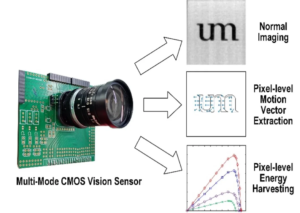Wu Jiangchao, a PhD student in the Department of Electrical and Computer Engineering, Faculty of Science and Technology, University of Macau (UM), and a research team led by his supervisor Law Man Kay, associate professor in UM’s Institute of Microelectronics, have developed the first multimode CMOS vision sensor chip which not only enables efficient optical flow extraction of moving objects but also achieves uninterrupted solar energy harvesting. The chip can reduce data bandwidth requirement while improving energy efficiency and lowering maintenance costs. The research result has been published in the well-known international journal IEEE Sensors Journal and will serve as an important reference for the future development of self-powered image sensor systems.
Ubiquitous wireless sensor nodes play an important role in future internet of things applications, with visual perception being the most important sensing domain in various monitoring scenarios. To fulfill the trend of continuous environment monitoring with emerging technologies such as artificial intelligence, intelligent transport, and indoor/outdoor monitoring, a multimode CMOS vision sensor with on-chip motion direction detection and energy harvesting capabilities can reduce the data bandwidth requirement of these devices while improving their energy efficiency, effectively relaxing the maintenance costs associated with frequent battery replacement.
Titled ‘A Multimode CMOS Vision Sensor With On-Chip Motion Direction Detection and Simultaneous Energy Harvesting Capabilities’, the study proposes an energy-efficient and lightweight optical flow algorithm for on-chip motion direction detection. It utilises vertically stacked photodiodes for independent imaging and energy harvesting, effectively breaking the bottleneck in the conventional pixel-level photodiodes reconfiguration approach while improving the achievable spatial resolution and energy harvesting efficiency. Fabricated in the standard size of CMOS (0.18-µm), the chip prototype has a pixel size of only 4.75µm. This is also the first CMOS vision sensor that has achieved motion direction detection and energy harvesting at the pixel level.
Prof Law is the paper’s corresponding author and Wu is the first author. PhD student Lu Xin, Prof Yang Jiang, Prof Liu Liyuan, Prof Mak Pui In, and Prof Rui Martins also made important contributions to the study. The project was funded by the Science and Technology Development Fund of Macao (File no: 148/2020/A3, 011/2019/APJ, 069/2016/A2, SKL-AMSV(UM)-2020-2022) and University of Macau (File no: CPG2022-00011-IME).
To view the full version of the paper, please visit: https://ieeexplore.ieee.org/stamp/stamp.jsp?arnumber=9789972
澳門大學科技學院電機及電腦工程系、微電子研究院副教授羅文基和博士生吳江潮研發出一款多功能視覺傳感器芯片,能減少數據傳輸的帶寬需求,並有效提升系統運行時間及減少維護成本,是首塊在像素層面實現運動方向檢測和能量採集功能的CMOS視覺傳感器芯片。相關研究成果已刊登於國際著名期刊《IEEE 傳感器雜誌》(IEEE Sensors Journal),為往後開發自供電圖像傳感器系統架構提供重要參考。
無處不在的無線傳感節點在物聯網應用中扮演著重要的角色,而視覺感知在各種監測場景中尤為重要。由於人工智能、智能交通、室內/室外監控等新興應用對環境進行不間斷監測的應用趨勢,具有能量採集功能的低功耗運動方向檢測圖像傳感器能減少數據傳輸的帶寬需求,並有效提升其系統運行時間及減少電池更換所帶來的維護成本。
該項研究成果以“具備片上運動方向檢測及無間斷能量收集功能的多模式 CMOS 視覺傳感器”(A Multimode CMOS Vision Sensor With On-Chip Motion Direction Detection and Simultaneous Energy Harvesting Capabilities)為題,提出一種用於片上運動方向檢測的高能效輕量級光流算法,並利用了垂直堆疊的光電二極管結進行獨立圖像成像和能量收集,突破了傳統對光電二極管的重置需求,有效提高空間分辨率及能量收集效率。此圖像傳感器芯片製造於0.18微米標準CMOS工藝,像素尺寸僅為4.75微米,是首塊在像素層面實現運動方向檢測和能量採集功能的CMOS視覺傳感器芯片。
該論文通訊作者為羅文基, 吳江潮為文章第一作者;博士生盧欣、江洋教授、劉力源教授、 麥沛然教授及馬許願教授也對此研究作出重要貢獻。此項研究由澳門特別行政區科學技術發展基金(檔案編號:148/2020/A3,011/2019/APJ,069/2016/A2, SKL-AMSV(UM)-2020-2022),及澳門大學(檔案編號:CPG2022-00011-IME)資助。全文可瀏覽:https://ieeexplore.ieee.org/stamp/stamp.jsp?arnumber=9789972
A multi-mode CMOS vision sensor chip
多模式 CMOS 視覺傳感器
(Left) Wu Jiangchao and Law Man Kay
(左)吳江潮及羅文基



